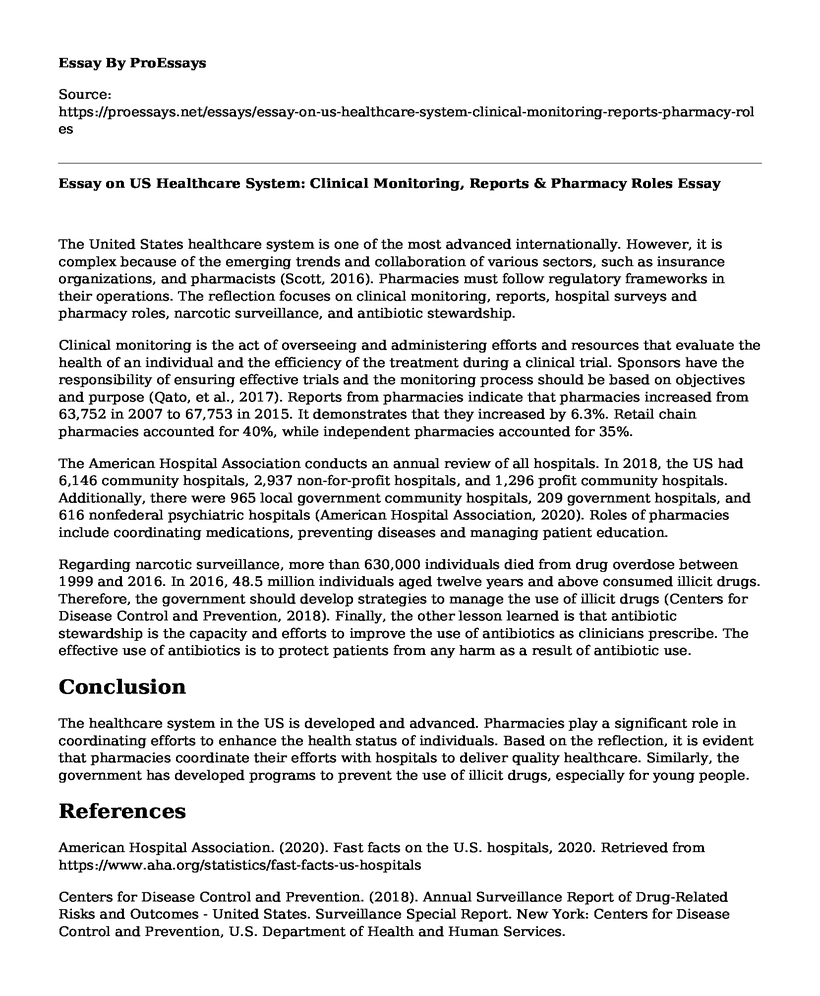The United States healthcare system is one of the most advanced internationally. However, it is complex because of the emerging trends and collaboration of various sectors, such as insurance organizations, and pharmacists (Scott, 2016). Pharmacies must follow regulatory frameworks in their operations. The reflection focuses on clinical monitoring, reports, hospital surveys and pharmacy roles, narcotic surveillance, and antibiotic stewardship.
Clinical monitoring is the act of overseeing and administering efforts and resources that evaluate the health of an individual and the efficiency of the treatment during a clinical trial. Sponsors have the responsibility of ensuring effective trials and the monitoring process should be based on objectives and purpose (Qato, et al., 2017). Reports from pharmacies indicate that pharmacies increased from 63,752 in 2007 to 67,753 in 2015. It demonstrates that they increased by 6.3%. Retail chain pharmacies accounted for 40%, while independent pharmacies accounted for 35%.
The American Hospital Association conducts an annual review of all hospitals. In 2018, the US had 6,146 community hospitals, 2,937 non-for-profit hospitals, and 1,296 profit community hospitals. Additionally, there were 965 local government community hospitals, 209 government hospitals, and 616 nonfederal psychiatric hospitals (American Hospital Association, 2020). Roles of pharmacies include coordinating medications, preventing diseases and managing patient education.
Regarding narcotic surveillance, more than 630,000 individuals died from drug overdose between 1999 and 2016. In 2016, 48.5 million individuals aged twelve years and above consumed illicit drugs. Therefore, the government should develop strategies to manage the use of illicit drugs (Centers for Disease Control and Prevention, 2018). Finally, the other lesson learned is that antibiotic stewardship is the capacity and efforts to improve the use of antibiotics as clinicians prescribe. The effective use of antibiotics is to protect patients from any harm as a result of antibiotic use.
Conclusion
The healthcare system in the US is developed and advanced. Pharmacies play a significant role in coordinating efforts to enhance the health status of individuals. Based on the reflection, it is evident that pharmacies coordinate their efforts with hospitals to deliver quality healthcare. Similarly, the government has developed programs to prevent the use of illicit drugs, especially for young people.
References
American Hospital Association. (2020). Fast facts on the U.S. hospitals, 2020. Retrieved from https://www.aha.org/statistics/fast-facts-us-hospitals
Centers for Disease Control and Prevention. (2018). Annual Surveillance Report of Drug-Related Risks and Outcomes - United States. Surveillance Special Report. New York: Centers for Disease Control and Prevention, U.S. Department of Health and Human Services.
Qato, et al., (2017). The availability of pharmacies in the United States: 2007-2015. PLoS ONE, 12(8), 1-18.
Scott, D. M. (2016). United States Health Care System: A Pharmacy Perspective. The Canadian Journal of Hospital Pharmacy, 69(4), 306-315.
Cite this page
Essay on US Healthcare System: Clinical Monitoring, Reports & Pharmacy Roles. (2023, Apr 23). Retrieved from https://proessays.net/essays/essay-on-us-healthcare-system-clinical-monitoring-reports-pharmacy-roles
If you are the original author of this essay and no longer wish to have it published on the ProEssays website, please click below to request its removal:
- Poverty is Capability of Deprivation
- Essay Example on Pathophysiology: Obesity
- The Death Penalty in the US - Paper Example
- American Music of 20th Century Essay
- Essay on Darwinism and American Society
- Attitudinal Issues Regarding Abortion - Essay Sample
- Research Paper on Stroke: A Leading Cause of Death & Disability in US







